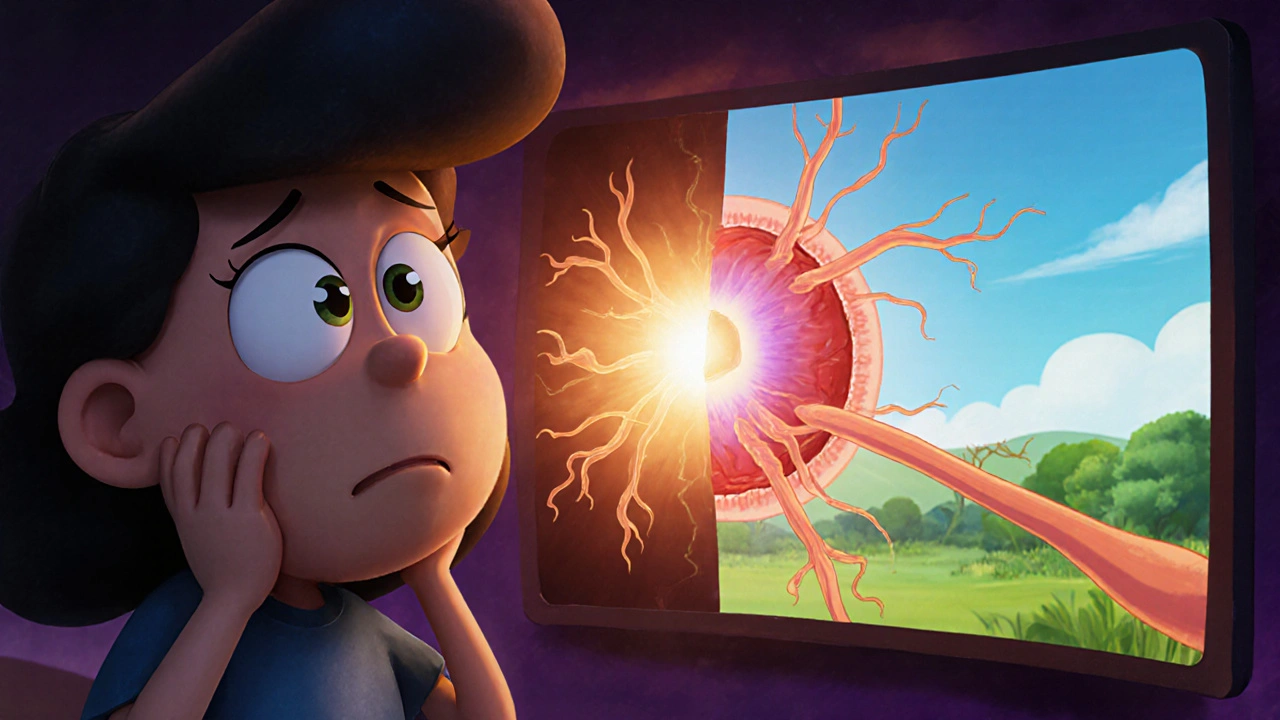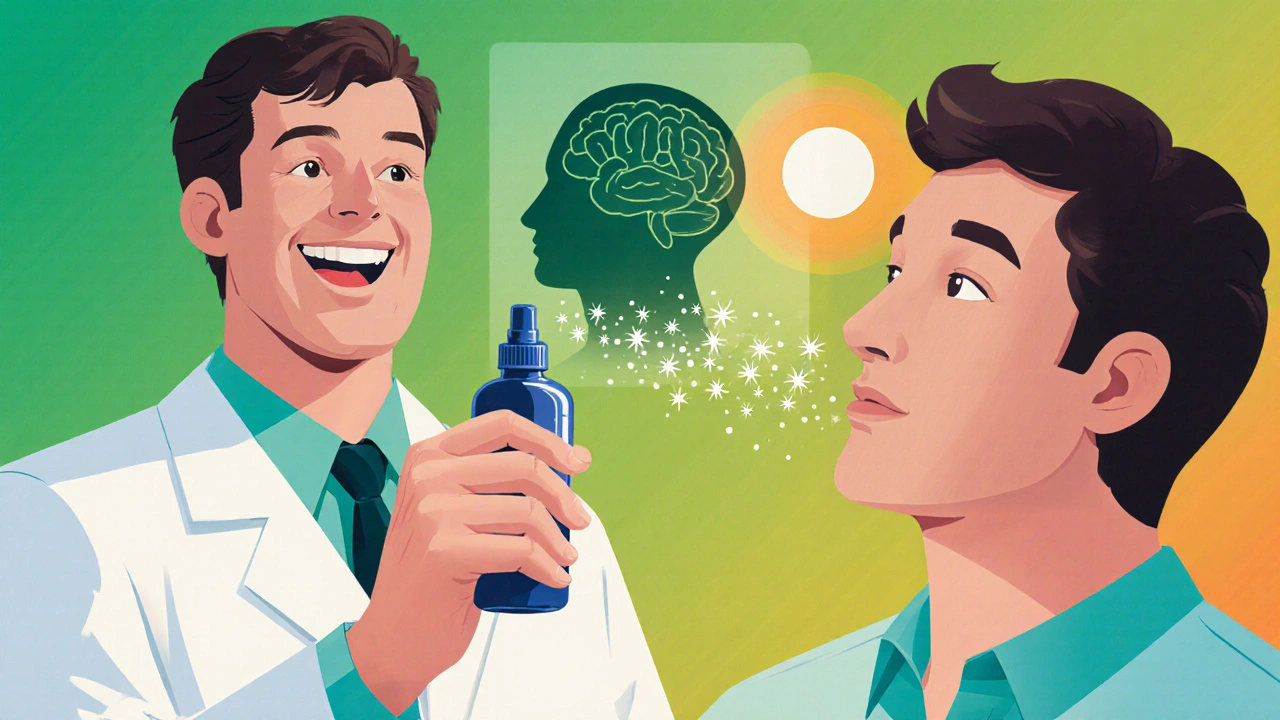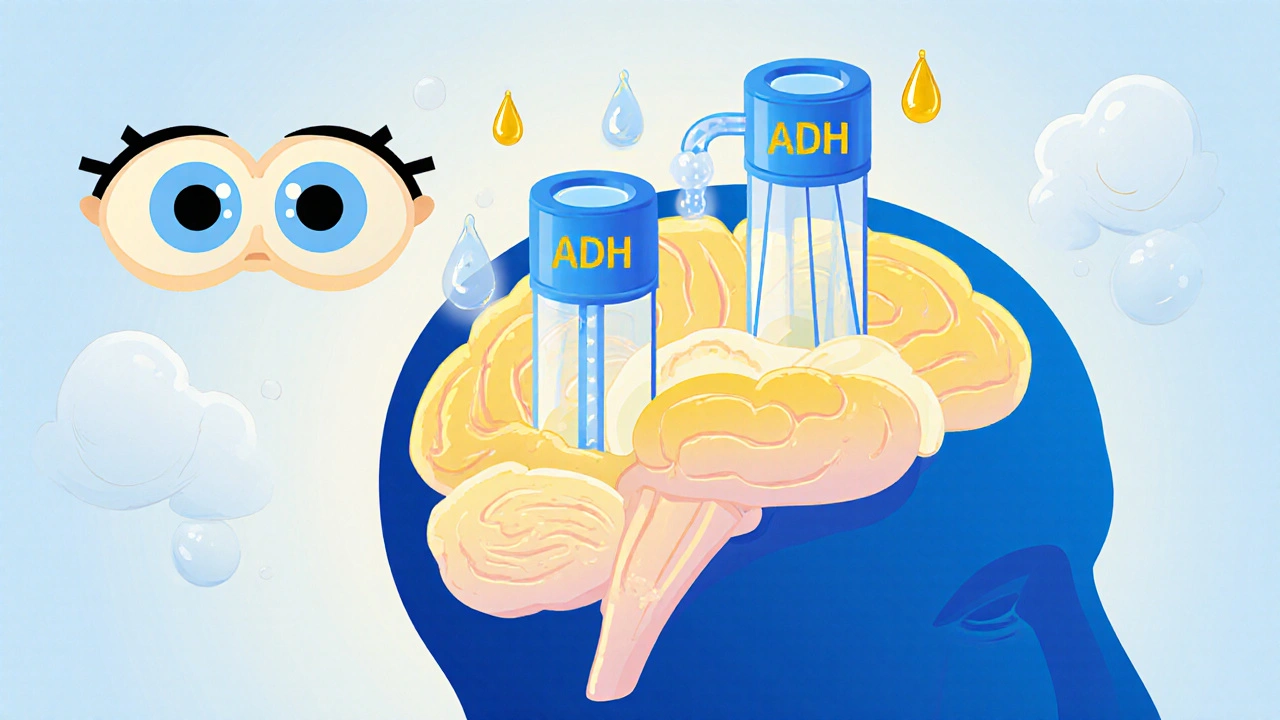CDI Fluid Balance Calculator
Maintain Safe Serum Sodium Levels
Proper fluid balance is critical for managing central cranial diabetes insipidus. Maintaining serum sodium between 135-145 mmol/L reduces risk of vision complications from dehydration or over-hydration.
Use this calculator to determine if your fluid intake is in a safe range based on your urine output.
Enter your data to see results
When the brain’s water‑balance system goes haywire, the ripple effects can reach the eyes. central cranial diabetes insipidus is a rare hormone disorder that often hides behind headaches, excessive thirst, and, surprisingly, vision disturbances.
Key Takeaways
- Central cranial diabetes insipidus (CDI) stems from a deficit of antidiuretic hormone (ADH) produced in the hypothalamus.
- Vision problems arise mainly from increased intracranial pressure, optic‑nerve swelling, or co‑existing pituitary tumors.
- Diagnosis relies on the water‑deprivation test, MRI imaging, and careful eye examinations.
- Desmopressin is the frontline medication; protecting eye health may require steroids, surgery, or pressure‑lowering measures.
- Regular monitoring of fluid intake, serum sodium, and visual fields can catch complications early.
What Is Central Cranial Diabetes Insipidus?
Central cranial diabetes insipidus is a disorder where the hypothalamus or posterior pituitary fails to release adequate antidiuretic hormone (ADH), also called vasopressin. Without ADH, the kidneys can’t re‑absorb water, leading to large volumes of dilute urine (polyuria) and relentless thirst (polydipsia). Common triggers include traumatic brain injury, pituitary surgery, infiltrative diseases, and rare genetic mutations.
How Does CDI Affect Vision?
Vision issues don’t come from the hormone itself; they’re secondary effects of the underlying brain changes. The most frequent pathways are:
- Increased intracranial pressure (ICP): Fluid loss can cause dehydration, prompting the brain to swell or develop edema, which compresses the optic nerves.
- Pituitary or hypothalamic tumors: Lesions that damage ADH production often sit near the optic chiasm, causing visual‑field defects.
- Papilledema: Swelling of the optic disc from ICP can blur vision and produce transient visual loss.
Patients may report blurred vision, double vision, or loss of peripheral sight - classic signs that warrant a full ophthalmologic work‑up.
Common Causes Linking CDI and Eye Problems
Understanding the root causes helps tailor both endocrine and ophthalmic treatment.
- Traumatic brain injury - Direct damage to the hypothalamic‑pituitary axis can disrupt ADH release and also cause hemorrhage that raises ICP.
- Pituitary adenoma - A benign tumor that presses on the optic chiasm, producing bitemporal hemianopia while simultaneously impairing ADH secretion.
- Craniopharyngioma - Often seen in children, this cystic tumor can block CSF flow, elevate ICP, and damage ADH‑producing cells.
- Sarcoidosis - Granulomatous infiltration of the hypothalamus can cause CDI; granulomas near the optic nerve provoke visual loss.

Diagnosing CDI and Associated Vision Problems
Accurate diagnosis is a two‑pronged approach.
Endocrine Work‑up
- Water‑deprivation test - Patients fast from fluids; urine osmolality is measured. In CDI, urine remains dilute until synthetic ADH (desmopressin) is given, after which osmolality rises sharply.
- Serum sodium and osmolarity - Hypernatremia (>145mmol/L) often flags severe water loss.
- Magnetic resonance imaging (MRI) of the brain - Looks for pituitary stalk lesions, tumors, or posterior‑pituitary “bright spot” loss.
Ophthalmic Evaluation
- Visual‑field testing - Detects peripheral cuts typical of chiasmal compression.
- Fundoscopy - Checks for papilledema or optic‑nerve pallor.
- Optical coherence tomography (OCT) - Quantifies retinal nerve‑fiber layer swelling.
Treatment Options for CDI and Vision Protection
Managing the hormone deficit and safeguarding the eyes often require coordinated care.
Hormone Replacement
The gold‑standard drug is desmopressin (synthetic ADH). It can be administered as nasal spray, oral tablet, or sublingual melt. Doses are titrated to keep urine output under 2L/day and maintain serum sodium between 135‑145mmol/L.
Addressing the Underlying Lesion
- Surgical resection of pituitary adenomas - Relieves optic‑chiasm pressure and often restores some ADH function.
- Radiation therapy for inoperable tumors - Can shrink mass effect, reducing ICP.
- Corticosteroids for sarcoidosis - Reduce granulomatous inflammation around the optic nerve.
Managing Intracranial Pressure
If ICP remains high despite tumor control, doctors may employ acetazolamide, osmotic agents (mannitol), or ventricular shunting. Lowering pressure frequently improves papilledema and visual acuity.
Eye‑Specific Interventions
- Topical steroids for optic‑nerve edema - Used under ophthalmologist supervision.
- Visual‑field rehabilitation - Training exercises that help patients adapt to peripheral loss.
Practical Tips for Daily Life
- Track fluid intake and output - A simple notebook or phone app can flag dangerous drops in urine concentration.
- Check serum sodium every 3‑6months if on desmopressin.
- Get a full eye exam at diagnosis and then annually, or sooner if vision changes.
- Avoid dehydration triggers - excessive heat, strenuous exercise without water, or diuretic medications.
- Carry an emergency card detailing your diagnosis, desmopressin dose, and contact information for your endocrinologist.

When to Seek Immediate Care
Call emergency services if you experience any of the following:
- Sudden loss of peripheral vision or double vision.
- Severe headache accompanied by nausea, vomiting, or altered consciousness - signs of rising ICP.
- Serum sodium >150mmol/L or <130mmol/L, indicating over‑ or under‑correction.
- Rapid increase in urine volume (>4L/day) despite medication.
Comparison: Central vs. Nephrogenic Diabetes Insipidus
| Feature | Central DI | Nephrogenic DI |
|---|---|---|
| Cause | Deficient ADH production (hypothalamus or posterior pituitary) | Kidneys unresponsive to ADH |
| Response to desmopressin | Marked increase in urine osmolality | Minimal or no response |
| Common triggers | Brain injury, tumors, surgery | Lithium, hypercalcemia, genetic mutations |
| Typical visual complications | Often present due to associated brain lesions | Rare, unless secondary brain pathology exists |
Frequently Asked Questions
Can central diabetes insipidus cause permanent vision loss?
Permanent loss is uncommon if the underlying cause-such as a tumor or high intracranial pressure-is treated promptly. Delayed treatment can lead to optic‑nerve atrophy, which is harder to reverse.
Is desmopressin safe for people with eye disease?
Desmopressin itself does not affect the eyes. However, over‑correction can cause hyponatremia, leading to brain swelling and secondary visual symptoms. Monitoring serum sodium prevents this risk.
How often should I have an eye exam after a CDI diagnosis?
At least once a year, or sooner if you notice any visual change, new headaches, or if imaging shows a growing lesion.
What lifestyle changes help control CDI symptoms?
Stay hydrated, avoid excessive caffeine or alcohol, keep a regular sleep schedule, and maintain a low‑salt diet to help manage serum sodium levels.
Can surgery cure both CDI and vision problems?
If a pituitary tumor is the culprit, surgical removal often restores ADH production and relieves pressure on the optic chiasm, improving both endocrine balance and visual fields. Success depends on tumor size and location.


Trina Smith
October 15, 2025 AT 16:11We often overlook how a hormone imbalance can ripple through the nervous system, whispering subtle warnings to our eyes 👁️. The link between central CDI and visual disturbances feels almost poetic-like a hidden dialogue between the brain’s water‑balance and the optic pathways. Remember that increased intracranial pressure isn’t just a headache; it can tug at the optic nerves, leading to blurred vision. Keeping an eye on fluid intake and regular neuro‑ophthalmic exams feels like tending a garden, nurturing both mind and sight. 🌿
Jacob Smith
October 16, 2025 AT 08:51Yo, this stuff is real crazy. If ur dehydrated a lot, ur brain can swell and mess with ur vision. Desmopressin helps a ton but dont forget to see an eye doc regular. Stay hydrated, bro, and keep that water bottle handy! 💪
Sönke Peters
October 17, 2025 AT 01:31CDI’s effect on vision is mostly about pressure and tumor proximity. Keep tabs on any changes.
Paul Koumah
October 17, 2025 AT 18:11Oh great another hormone that decides to play hide‑and‑seek with your optic nerve. Nothing like a little papilledema to spice up your day.
Erica Dello
October 18, 2025 AT 10:51Central CDI demands strict monitoring serum sodium levels avoid hyponatremia even mild fluctuations can affect brain volume and vision watch fluid balance meticulously adherence to desmopressin dosing schedule is essential regular visual field testing should not be optional
Marcia Hayes
October 19, 2025 AT 03:31Super useful rundown! I’d add that a simple daily log of water intake can really help catch problems early. Keep sharing these gems! 😊
Danielle de Oliveira Rosa
October 19, 2025 AT 20:11The relationship between central cranial diabetes insipidus and visual dysfunction invites us to contemplate the interconnectedness of bodily systems.
When the hypothalamus fails to secrete adequate ADH, the ensuing polyuria and polydipsia set off a cascade that can elevate intracranial pressure.
Elevated pressure, in turn, exerts mechanical force on the optic nerves, a phenomenon that is both physiologically logical and clinically observable.
Moreover, the anatomical proximity of the pituitary stalk to the optic chiasm means that any lesion-be it a tumor, cyst, or inflammatory mass-may simultaneously compromise hormone production and visual pathways.
From a therapeutic standpoint, desmopressin restores water balance and reduces urine output, thereby mitigating one source of pressure fluctuation.
Yet, clinicians must remain vigilant because the medication itself can precipitate hyponatremia, a condition that paradoxically induces cerebral edema and visual blurring.
Regular monitoring of serum sodium, therefore, is not a bureaucratic checkbox but a lifesaving practice.
Likewise, serial visual‑field testing provides an early warning system for optic‑nerve compromise, often before patients notice subtle peripheral loss.
When a pituitary adenoma is identified, surgical resection can relieve chiasmal compression and sometimes allow residual ADH‑producing cells to recover function.
In cases where surgery is contraindicated, radiosurgery or targeted radiation may shrink the mass sufficiently to improve both endocrine and visual outcomes.
For inflammatory etiologies such as sarcoidosis, systemic corticosteroids reduce granulomatous infiltration, protecting both the hypothalamic–pituitary axis and the optic apparatus.
The multidisciplinary nature of CDI management underscores the necessity of collaboration between endocrinologists, neurosurgeons, and ophthalmologists.
Patients, too, become active participants by tracking fluid intake, noting any visual changes, and adhering to medication schedules.
Technology can assist; smartphone apps that log urine volume and fluid consumption are increasingly user‑friendly and can alert clinicians to trends.
Ultimately, the goal is not merely to normalize laboratory values but to preserve the quality of life, which includes maintaining clear vision.
By viewing CDI through the lens of systems biology, we appreciate that a hormone deficiency is never an isolated event but a signal that reverberates throughout the organism.
Tarun Rajput
October 20, 2025 AT 12:51Esteemed members of this forum, I feel compelled to elaborate on the nuanced pathophysiology that underlies central diabetes insipidus and its ophthalmic sequelae. The hypothalamic‑pituitary axis, a delicate orchestration of neuroendocrine signals, when disrupted, precipitates a cascade of fluid‑electrolyte derangements that can culminate in increased intracranial tension. This tension, akin to a pressure cooker, exerts insidious stress upon the optic nerve sheaths, potentially engendering papilledema and transient visual obscuration. Moreover, the anatomical adjacency of the pituitary macroadenoma to the optic chiasm renders visual field defects, classically bitemporal hemianopia, a frequent clinical vignette. Therapeutic intervention, therefore, must be twofold: pharmacologic restitution of antidiuretic hormone via desmopressin, and, when warranted, surgical decompression of the chiasmal corridor. In my experience, a meticulous regimen of serial MRI surveillance coupled with periodic perimetry yields the most favorable prognostic trajectory. I would also advocate for patient‑centred education, empowering individuals to maintain diligent fluid diaries and to recognize early visual cues. In conclusion, the confluence of endocrine and ophthalmologic stewardship epitomizes the essence of multidisciplinary medicine, and I commend the authors for illuminating this critical intersection.
Joe Evans
October 21, 2025 AT 05:31Great post! 😊 I love how it breaks down the steps-first, check your water intake; second, get regular eye exams; third, keep up with desmopressin dosing. It’s super helpful for anyone dealing with CDI! 👍
Colin Boyd
October 21, 2025 AT 22:11While the article is thorough it glosses over the fact that many patients never develop vision problems even with significant intracranial pressure the narrative seems overblown
Annie Tian
October 22, 2025 AT 14:51What an enlightening summary! It emphasizes the importance of early detection, regular monitoring, and collaborative care, all of which are essential for preserving both endocrine function and visual acuity, and it offers practical tips that patients can readily implement, such as maintaining a fluid log and scheduling annual ophthalmic examinations, which I find particularly encouraging.
April Knof
October 23, 2025 AT 07:31Understanding the cultural context of endocrine disorders can enhance patient compliance.
Tina Johnson
October 24, 2025 AT 00:11While the foregoing points are accurate, they fail to address the socioeconomic barriers that limit access to MRI imaging and specialist ophthalmology, thereby perpetuating disparities in outcomes for underprivileged populations; a more comprehensive analysis would incorporate these vital considerations.
Sharon Cohen
October 24, 2025 AT 16:51It’s fascinating how a hidden hormonal glitch can silently steal the colors from our world, leaving us to stare at a dimmed horizon; the subtle loss of peripheral vision feels like a film fading into grayscale, a reminder of how delicate the balance of our body truly is.
Rebecca Mikell
October 25, 2025 AT 09:31I agree that multidisciplinary follow‑up is key, and I’d add that patient education materials should be made available in plain language to ensure everyone, regardless of background, can understand the warning signs of visual decline.
Kyah Chan
October 26, 2025 AT 02:11The exposition suffers from a lack of critical appraisal regarding the long‑term efficacy of desmopressin, neglecting to cite recent longitudinal studies that reveal potential tachyphylaxis; moreover, the superficial treatment of surgical outcomes betrays an inadequate engagement with the underlying data.
Ira Andani Agustianingrum
October 26, 2025 AT 18:51Thanks for the thorough overview! I’d just emphasize that patients should feel comfortable asking their doctors about any new visual symptoms right away, because early intervention can make a huge difference in preserving sight.
James Higdon
October 27, 2025 AT 11:31It is incumbent upon healthcare providers to uphold the highest standards of vigilance when managing central diabetes insipidus, ensuring that no patient’s vision is compromised through neglect or oversight.